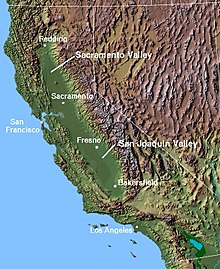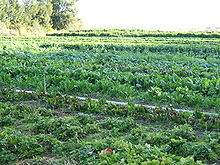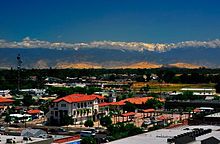Central Valley (California)
![]()
Central Valley is a redirect to this article. For other meanings, see Central Valley (disambiguation).
The California Central Valley is a valley in central California that is over 600 kilometers long and up to 80 kilometers wide.
It is bordered on all sides by mountain ranges: The California Coast Range to the west, the Sierra Nevada Mountains to the east, the Klamath Mountains to the north, and the Tehachapi Mountains to the south. The valley is drained by the Sacramento River to the north and San Joaquin River to the south. The northern part of the valley is also called Sacramento Valley after these rivers, and the southern part is called San Joaquin Valley. Both rivers join just north of the center of the valley and drain west through the valley's only natural opening into San Francisco Bay.
California's Long Valley is in the subtropical winter rainfall climate range; almost all precipitation falls from December through April. In contrast, arid climate prevails in summer. There is more rainfall (moderate precipitation) in the north than in the low rainfall south. The Pacific High, which is located in southwestern California west of the coastal mountains in summer, cannot bring precipitation to the southern part of the valley because access is denied by the mountains. Originally, almost the entire valley was grassland, remnants of which are preserved only in Carrizo Plain National Monument, as intensive agriculture is now practiced.
The valley lies to the west of the agronomic dry line, which means that rain-fed agriculture is no longer possible. Artificial irrigation is possible due to groundwater reserves in the south, but this poses risks such as salinization and a decline in soil fertility. Temperatures in the Längstal seldom fall below 8 °C, even in winter, making year-round cultivation possible. The typical vegetation type of the Longitudinal Valley is California white oak (Quercus lobata), California stone oak (Quercus agrifolia) savanna, which is used by endemics such as the yellow-billed magpie (Pica nuttalli).
The valley is often called the fruit garden of America. The entire USA is supplied from here, and goods are also exported to other countries. The crops are especially popular in the USA because they are very rare. These can be dates, almonds, rare fruits and vegetables or wine. In the total area of more than 50,000 square kilometers, about 250 different agricultural products are grown, generating a turnover of 17 billion US dollars (2009).
Special methods have been devised to protect the crops. These include stoves, which are set up in winter to stir up the cold air, as frequent cold fall winds could otherwise cause the fruit to freeze. Alternatively, the fruits and vegetables are sprayed with water. When the water freezes, heat is released (heat of crystallization), so that the temperature of the fruit can be kept at the freezing point for quite a while - their juice freezes only at lower temperatures because of the dissolved substances.
One major problem, however, is irrigation. Since there are differences in altitude of up to 600 meters, the water often has to be pumped uphill. For this purpose, the farmers have installed nearly 200 electric pumps, which, however, consume a lot of energy and are very expensive to purchase and maintain. Furthermore, there are also canals, but these are at great risk of evaporation because they run unprotected over the terrain and are exposed to sunlight. The remedy is underground water tunnels, which are usually in the mountains and take the water from there. Another option is dams. They capture and store water from snowmelt each year. This water is in turn used to generate electricity, which can then power the pumps.
The fruit orchard is one of the largest consumers of energy and groundwater in the U.S., which is especially a problem in water-scarce southern California.
The location between the two parallel mountain ranges at right angles to the main wind direction leads to frequent inversion weather conditions. Since population growth beginning in the mid-20th century, this often results in smog. Particulate matter pollution is also high in the Central Valley because of these climatic conditions: half of all cities in the USA that exceed the WHO limit are located in California's Long Valley.
The Central Valley is threatened by catastrophic arkstorms.

Map of California Long Valley

Growing vegetables in California's longitudinal valley

View over Visalia in the California Long Valley. In the background the Sierra Nevada
Questions and Answers
Q: What is the Central Valley?
A: The Central Valley is a very large valley in the middle of California, in the United States. It consists of two connected, differently named valleys, the Sacramento Valley and the San Joaquin Valley.
Q: How big is it?
A: The Central Valley is about 42,000 square miles (108,779 square kilometers) in size, which is roughly equivalent to the size of the state of Tennessee.
Q: Where are its borders?
A: The Sierra Nevada Mountains border the valley on its east side while the Coast Range borders it on its west side.
Q: What rivers flow through it?
A: The Sacramento River flows through the north part of the Central Valley and is also called Sacramento Valley. Meanwhile, San Joaquin River flows through south part of Central Valley and this area is also known as San Joaquin Valley. Both rivers eventually merge and empty into Pacific Ocean via San Francisco Bay.
Q: Where is California's capital located?
A: California's capital city, Sacramento, can be found in north part of Central Valley.
Q: How long does it stretch for?
A: In total, Central Valley stretches for around 450 miles (720 km).
Q: How many counties does it have?
A: There are 18 counties within Central Valley's boundaries. 15 out these 18 counties are among 25 most productive farmland in California.
Search within the encyclopedia